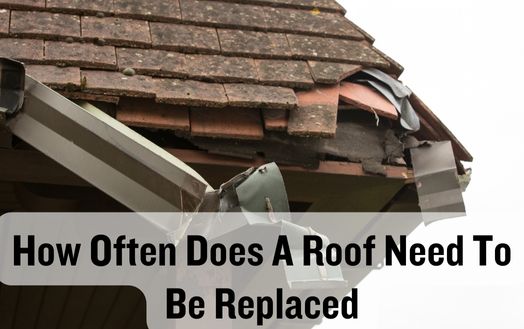As the saying goes, ‘out of sight, out of mind.’ This applies to our roofs, which we often neglect until they break. How often does a roof need to be replaced? Our answer may be complicated due to several factors.
This discussion will cover the average lifespan of different roofing materials, signs that a roof needs replacing, the importance of regular roof inspections, and how weather affects roof longevity. You’ll understand the topic and be able to protect one of your most valuable assets by the end.
Factors Affecting Roof Lifespan
There are several major factors that affect the lifespan of a roof. To prolong your roof’s life, innovative audiences seeking roof replacement and maintenance must understand these factors.
Roof material comes first. Roof materials vary in lifespan. Asphalt shingles last 20–25 years, while metal roofs can last 50 years or more. Using high-quality materials can extend the life of your roof and reduce replacements.
Proper installation is essential. Poor roof installation increases damage and aging. Hire professional roofing contractors who follow best practices. This will prolong your roof’s life and reduce costly repairs.
Roofs need regular maintenance to last longer. Routine inspections, debris cleanup, and prompt resolution of minor issues can prevent major issues. Maintaining your roof regularly can also help you spot problems early and extend its lifespan.
Environmental factors also affect roof longevity. Heavy rain, strong winds, and prolonged sunlight can damage your roof. Making sure your roof is designed and installed to withstand these conditions can extend its lifespan.
Average Lifespan Of Different Roofing Materials

After learning about roof lifespan factors, it’s important to compare roofing material lifespans. The frequency of roof replacement depends on the roofing material. Here are four common roofing materials’ average lifespans:
- Asphalt Shingles: The most popular roofing material, asphalt shingles have an average lifespan of 15 to 30 years. They’re cost-effective and easy to install, making them a popular choice for many homeowners. However, they may be prone to damage from harsh weather conditions and may require more frequent replacement.
- Metal Roofing: Metal roofs have an average lifespan of 30 to 50 years. They’re known for their durability and resistance to fire, rot, and insect damage. Metal roofs are also energy-efficient, reflecting heat and reducing cooling costs. With proper maintenance, they can last even longer than the average lifespan.
- Clay or Concrete Tiles: Clay or concrete tiles have an average lifespan of 50 to 100 years. These roofing materials are highly durable and can withstand extreme weather conditions. They’re also energy-efficient and provide good insulation. However, they’re heavier and may require additional structural support.
- Slate: Slate roofs have the longest average lifespan, lasting up to 100 years or more. Slate is a natural stone that offers exceptional durability and resistance to fire and rot. It’s also an environmentally friendly option. However, slate is expensive and requires specialized installation and maintenance.
For informed roof replacement decisions, homeowners must know the average lifespan of different roofing materials. Choose a durable roofing material to reduce roof replacements and protect your home.
Signs That Indicate A Roof Replacement Is Needed
Your roof may need replacement if it has extensive damage or deterioration. As an innovative homeowner, you know how important it is to recognize roof replacement signs. Recognition of these signs early can prevent further damage and prolong the life of your home.
Damage is one of the most obvious signs your roof needs replacing. Missing or damaged shingles, curling or buckling shingles, or roof sagging are examples. These signs mean your roof needs replacing to protect your home from the elements.
Also, watch for water damage. Water stains on ceilings or walls may indicate a leaking roof. Bad roof valleys, worn flashing, or cracked shingles may be to blame. Ignoring these signs could cause mold, structural damage, and costly repairs. Replace the roof right away to address these problems.
Replacement is also recommended for roofs over 20 years old. Most roofs last 20–25 years, even without damage. You can avoid leaks and major issues by replacing your roof now.
Importance Of Regular Roof Inspections
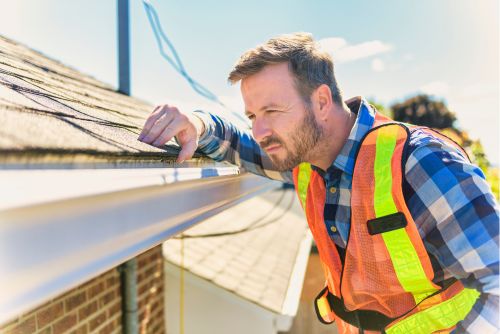
Maintaining roof integrity and longevity requires regular inspections. To avoid premature roof replacements, innovative homeowners must understand the importance of regular roof inspections. Regular roof inspections are necessary for four reasons:
- Early Detection of Issues: Regular inspections allow you to identify any potential roofing problems before they escalate into major issues. By catching problems early on, you can address them promptly, preventing further damage and potentially saving you from the high cost of a complete roof replacement.
- Prolonged Lifespan: A well-maintained roof can last significantly longer than one that’s neglected. Regular inspections help you identify areas that may require maintenance or repairs, allowing you to address them promptly. This proactive approach can extend the lifespan of your roof and delay the need for a replacement.
- Enhanced Energy Efficiency: A properly maintained roof contributes to improved energy efficiency in your home. During inspections, professionals can identify any gaps, leaks, or insulation issues that may be compromising your home’s energy efficiency. By addressing these problems, you can reduce your energy consumption and lower your utility bills.
- Peace of Mind: Regular roof inspections provide you with peace of mind, knowing that your roof is in good condition. By staying proactive and addressing any issues early on, you can avoid the stress and financial burden of a sudden roof replacement.
How Weather Conditions Impact Roof Longevity
As an innovative homeowner, I’ve learned that weather can greatly affect my roof’s longevity. A roof’s lifespan and replacement depend on the weather. My roof wears down due to my climate, so understanding how weather affects roof longevity is crucial to making informed roof maintenance and replacement decisions.
The weather affects roofing materials differently. Heat and cold can warp and crack shingles, while extreme cold can make them brittle and vulnerable. High winds can lift and dislodge shingles, exposing the structure to more damage. Leaks and water damage can result from improper roof sealing and maintenance during heavy rain and snow. Even long-term UV exposure can deteriorate roofing materials.
To prolong the life of my roof, I must choose the right materials for my climate. Some materials are better for certain weather conditions. Metal roofs are wind-, rain-, and snow-resistant. However, asphalt shingles are more weather-sensitive and may need to be replaced more often in harsh climates.
Regular inspections and maintenance help identify and resolve weather-related issues before they escalate. Being proactive and fixing problems quickly can extend the life of my roof and reduce the need for replacement. I can also prolong my roof by using high-quality materials and professional installation.
Tips For Maintaining A Roof’s Integrity
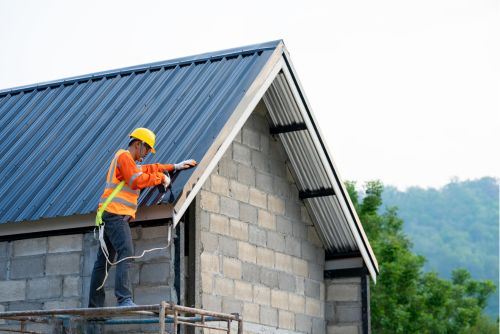
I prioritize roof inspections and maintenance to ensure its longevity. Proactive roof maintenance prevents problems and extends its lifespan. Here are four essential roof maintenance tips:
- Schedule Regular Roof Inspections: It’s crucial to have a professional roofing service conduct regular inspections to identify any signs of damage or wear. A thorough roof inspection can uncover hidden issues, such as loose shingles, damaged flashing, or cracked seals, that could lead to water damage if left unaddressed.
- Perform Routine Roof Maintenance: Regular maintenance tasks, such as cleaning gutters and downspouts, removing debris, and trimming overhanging branches, are essential to prevent clogs and water buildup. These simple steps help to maintain proper drainage and avoid potential water damage.
- Address Repairs Promptly: If your roof inspection reveals any areas in need of repair, it’s crucial to address them promptly. Ignoring small issues can lead to more significant problems over time, potentially resulting in costly repairs or even the need for a roof replacement. By taking care of repairs as soon as they’re identified, you can prevent further damage and extend the life of your roof.
- Consider Professional Roof Maintenance Programs: Many roofing services offer maintenance programs that provide regular inspections and preventative maintenance. These programs can help you stay on top of your roof’s needs and ensure that any potential issues are addressed promptly, saving you time, money, and potential headaches in the long run.
Common Causes Of Roof Damage
Weather is a major cause of roof damage. Understanding common roof damage causes is crucial to roof maintenance. Take precautions to protect your roof and avoid frequent replacements by knowing these factors.
Hail is a common roof damage cause. Hailstones vary in size and intensity and can damage your roof. Hail can cause roof cracks, dents, and punctures, which can lead to leaks and further damage if not repaired.
Strong winds frequently cause roof damage. High winds can lift and dislodge roofing materials, leaving gaps and letting water in. Strong winds can also drop trees or branches on your roof, causing significant damage that may require roof replacement.
Innovative solutions, like impact-resistant roofing materials, can reduce severe weather damage. These materials resist hail and strong winds, reducing the need for roof replacements.
Water seeping into your roof from heavy rainfall or snowfall can also cause roof damage, rot, and mold. Poor installation or maintenance can also cause roof issues and replacements.
The Role Of Proper Ventilation In Roof Durability
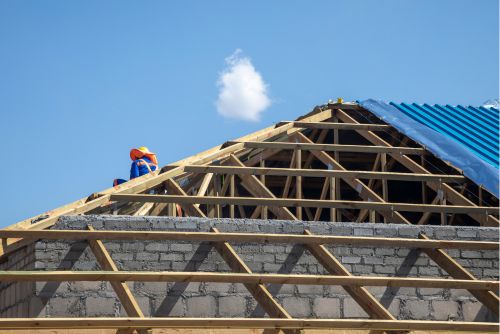
Roof durability depends on proper ventilation. A roof without proper ventilation can develop a variety of problems that require early replacement. Proper ventilation is crucial for roof longevity for four reasons:
- Moisture control: Moisture is one of the biggest enemies of a roof. Without proper ventilation, trapped moisture can accumulate in the attic, leading to the growth of mold and rotting of the underlying roof structure. By allowing for the flow of air, proper ventilation helps to prevent moisture buildup, keeping your roof dry and free from damage.
- Temperature regulation: Extreme temperature fluctuations can cause your roof materials to expand and contract, leading to cracks and deterioration over time. Proper ventilation helps to regulate the temperature in the attic, reducing the strain on your roof and prolonging its lifespan.
- Energy efficiency: An adequately ventilated roof helps to reduce heat buildup in the attic, which in turn helps to lower cooling costs during hot summer months. By keeping your attic cooler, proper ventilation contributes to overall energy efficiency and reduces the strain on your HVAC system.
- Shingle preservation: Inadequate ventilation can cause shingles to become excessively hot, leading to premature aging and reducing their lifespan. Proper ventilation helps to keep shingles at a moderate temperature, preserving their integrity and ensuring your roof remains durable for longer.
How To Choose The Right Roofing Material For Your Climate
After learning how ventilation affects roof longevity, it’s important to choose the right roofing material for your climate. Choosing the right roofing material can affect your roof’s lifespan and ability to withstand your climate.
Consider the local weather and climate when choosing a roofing material. Different roofing materials have strengths and properties that suit certain climates. In hot climates with intense sunlight, you may want a heat-resistant and UV-protected roofing material. In areas with heavy rain or snowfall, you may want to choose a durable material that can withstand moisture.
Maintenance needs for each roofing material should also be considered. Some materials require frequent inspections and repairs, while others are low-maintenance. Choose a roofing material that matches your maintenance needs.
In addition to climate and maintenance, roofing material aesthetics are important. The right roofing material can improve your home’s curb appeal.
Understanding The Warranty Coverage For Your Roof
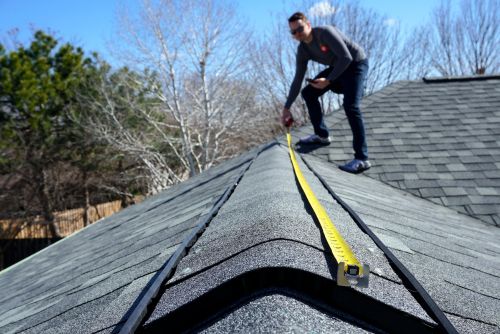
To fully understand your roof’s warranty coverage, read the manufacturer’s terms and conditions. This section clarifies roof replacement warranty coverage. Four important considerations:
- Duration: The duration of warranty coverage varies depending on the manufacturer and the type of roofing material used. It’s important to review the warranty document to determine the length of coverage provided. Some warranties may offer coverage for a specific number of years, while others may provide coverage for the lifetime of the roof.
- Scope of Coverage: Understanding the scope of coverage is crucial. Most warranties cover manufacturing defects and workmanship issues that may arise during the installation process. However, it’s important to note that warranties typically don’t cover damage caused by natural disasters or improper maintenance.
- Transferability: Some warranties are transferable, meaning they can be transferred to a new homeowner if you decide to sell your property. This can be an attractive feature, as it adds value to your home and reassures potential buyers that the roof is protected.
- Registration and Maintenance Requirements: Many warranties require registration within a certain timeframe after installation. Additionally, manufacturers often specify maintenance requirements that must be followed to keep the warranty valid. This may include regular inspections and necessary repairs. Failure to comply with these requirements can result in the warranty being voided.
DIY Vs Professional Roof Replacement
Understanding your roof’s warranty and how often does a roof need to be replaced is important, but there are other factors to consider when choosing between DIY and professional roof replacement.
DIY roof replacement can be appealing to home improvement enthusiasts who want to save money. Before choosing, weigh the pros and cons. Cost savings are a major benefit of DIY roof replacement. You can save thousands by buying materials and doing the work yourself. DIY projects offer more customization and flexibility because you control the design and timeline.
The risks and challenges of DIY roof replacement must be acknowledged. It takes a lot of time and effort. Ladder climbing, carrying heavy materials, and working in different weather conditions are physically demanding. Without professional help, errors or improper installation could lead to costly repairs.
However, professional roof replacement has many benefits. Professionals have the skills, experience, and tools to do the job well. They know the latest roofing techniques and innovations, ensuring a high-quality, durable result. Hiring professionals gives you peace of mind because they usually offer warranties.
The choice between DIY and professional roof replacement depends on your skills, resources, and preferences. It’s important to assess your skills, project complexity, and risks and benefits. Whether you replace your roof yourself or hire professionals, the most important thing is doing it right to protect your home and investment.
The Cost Factors Involved In Roof Replacements
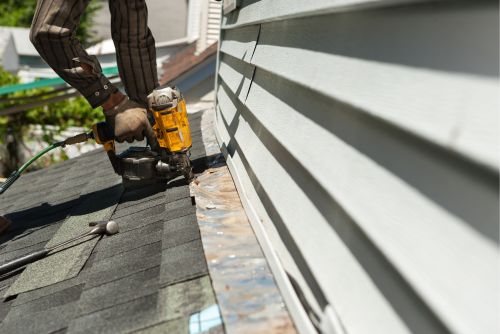
Understanding roof replacement costs is crucial. Roof replacement costs depend on several factors. Here are four important cost factors:
- Type of Roofing Material: The type of roofing material you choose can greatly impact the cost of a roof replacement. Different materials, such as asphalt shingles, metal, or tile, have different price points. Additionally, higher quality materials often come with a higher price tag.
- Size and Complexity of the Roof: The size and complexity of your roof will also affect the cost of a replacement. Larger roofs require more materials and labor, which can increase the overall cost. Roofs with complex designs or multiple angles may also require additional time and expertise, adding to the expense.
- Removal and Disposal of Old Roofing: Before a new roof can be installed, the old roofing material must be removed and properly disposed of. This process adds to the overall cost of the replacement. The amount of time and effort required for removal and disposal will depend on the type of roofing material being replaced.
- Additional Work or Repairs: During the roof replacement process, it may be necessary to address other issues or make repairs. This could include fixing damaged or rotted decking, replacing flashing, or addressing ventilation concerns. These additional repairs can increase the overall cost of the replacement.
These cost factors can help you estimate roof replacement costs. Understanding the factors that affect cost can help you choose a roofing material and decide if repairs are needed.
Extending The Lifespan Of Your Roof Through Repairs
Repairing your roof is essential to its longevity. Maintenance and repairs are necessary to keep your roof in good condition and last. Fixing roof leaks and inspecting them regularly can extend their lifespan and prevent costly replacements.
Regular maintenance is crucial to roof longevity. Clean debris from the roof and gutters, check for damage or wear, and seal the roof. Keep your roof clean and well-maintained to avoid water damage and mold growth, which can shorten its lifespan.
Repairs must be done quickly. Even a small roof leak can cause significant damage if ignored. To prevent roof and interior damage, find the leak and fix it immediately. Regular inspections can detect issues before they become major, allowing for timely repairs and roof longevity.
Innovative roofing technologies and materials can extend roof life. For instance, reflective coatings reduce UV rays and prevent premature deterioration. Advanced roofing systems are more durable and resistant to extreme weather, extending the life of your roof.
How To Spot Early Signs Of Roof Deterioration
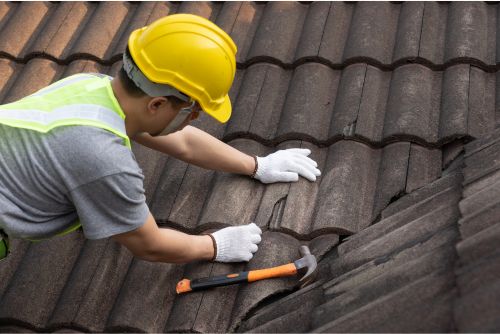
Regularly inspect your roof for visible damage or wear to spot early signs of deterioration. Early detection can prevent further damage and save you from replacing your roof. Identifying roof deterioration early involves four key signs:
- Missing or damaged shingles: Check for any shingles that are cracked, curled, or completely missing. These can leave your roof vulnerable to leaks and further deterioration.
- Granule loss: Take a closer look at your shingles and see if there are excessive amounts of granules in your gutters or downspouts. Granule loss can indicate that your shingles are aging and may need to be replaced soon.
- Water stains or leaks: Inspect your ceilings and walls for any signs of water stains or discoloration. These can be indications of roof leaks, which should be addressed promptly to prevent further damage.
- Sagging or uneven roof: Walk around your property and look for any areas where your roof appears to be sagging or uneven. This can be a sign of structural issues and should be assessed by a professional.
The Environmental Impact Of Roof Replacement
Checking for roof deterioration prevents further damage and lets us consider the environmental impact of roof replacement. When deciding how often to replace a roof, consider its environmental impact.
Due to materials and waste, roof replacement can harm the environment. Asphalt shingles contribute to landfill waste and require a lot of energy to make. Additionally, transporting these materials to you increases their carbon footprint.
Innovative roofing solutions are addressing environmental concerns. Sustainable roofing materials like metal or clay tiles are recyclable and last longer. These materials reduce roof replacement frequency and environmental impact.
Green roofs are another innovative roof replacement method. The vegetation on these roofs has many environmental benefits. Green roofs improve air quality, reduce stormwater runoff, and regulate building temperatures, saving energy. They help with urban greening and provide wildlife habitat.
Final Thoughts
In conclusion, it’s important to regularly inspect your roof and be aware of the signs of deterioration. By addressing repairs and maintenance promptly, you can extend the lifespan of your roof and avoid the need for a full replacement.
Additionally, considering the environmental impact of roof replacements is crucial, as it can contribute to waste and pollution. Taking proactive measures and being mindful of the materials used can help minimize the need for frequent roof replacements. So now you know how often does a roof need to be replaced.
Frequently Asked Questions
Can I Replace My Roof Myself, Or Should I Hire A Professional?
I’m debating whether to replace my roof myself or hire a pro. It’s a tough choice, given the importance of a well-installed roof.
Some may argue that DIY saves money, but I think hiring a professional is best. Their expertise and experience ensure a high-quality, long-lasting result, which is essential for my home’s integrity and innovation.
How Do I Choose The Right Roofing Material For My Climate?
Durability, insulation, and weather resistance should be considered when choosing a roofing material for your climate. Comparing options and consulting experts can help you decide.
Temperature, humidity, and precipitation should be considered. Your roof will last longer and perform better if you choose a material that can handle your climate.
What Are The Early Signs Of Roof Deterioration That I Should Look Out For?
I’ve noticed some signs of roof deterioration that homeowners should be aware of. Look out for:
- Missing or damaged shingles
- Sagging areas
- Water leaks
These can indicate underlying issues that may require immediate attention.
Regularly inspecting your roof and addressing any problems early on can help prevent further damage and extend its lifespan.
How Often Should I Have My Roof Inspected?
For longevity and to avoid major issues, I should have my roof inspected regularly. Regular inspections detect issues early, enabling prompt repairs and maintenance.
What Are The Environmental Impacts Of Roof Replacement?
When it comes to the environmental impacts of roof replacement, there are a few things to consider.
Firstly, the materials used in the new roof can have a significant impact. Opting for sustainable materials like metal or recycled shingles can help reduce the carbon footprint.
Secondly, the process of removing and disposing of the old roof can generate waste. Proper recycling and disposal methods should be employed to minimize the environmental impact.
Lastly, the energy efficiency of the new roof can also affect the environment positively by reducing energy consumption.

